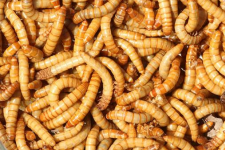Assessment of the digestive tolerance in dogs of a new diet based on insects as the protein source

Introduction
Recent research has shown that insects may be an alternative source of protein for animal nutrition. 1-3 Insects could also represent a “novel” protein source for managing adverse food reactions in pets. 4 Publications describe the high-quality nutritional profile of selected insect species, but there is little data on the tolerance in dogs of insect-based diets.5,6
Animals, materials and methods
Twenty-six healthy adult client-owned dogs were recruited and monitored for 28 days. After a 4-day diet transition, they were fed exclusively with the new diet (Table 1). This diet was formulated to meet FEDIAF requirements for adult dogs7 ,and was characterized by mealworm (Tenebrio molitor larvae) as the protein source. In this blind test, owners filled in online
multiple-choice questionnaires on D0 (basal assessment with usual diets), D7, D14 and D28. To evaluate tolerance of the diet, 4 parameters were assessed (Table 2).8 Owners also evaluated palatability, coat condition and their general satisfaction. Wilcoxon signed rank and Mc Nemar’s tests were used to compare results, with a 5% significance level.


Results
 The mean faecal score was similar (2.3±0.6) on D0 and D28, none of the dogs presented diarrhoea during the study. Faecal odour did not change significantly when switching to the test diet. On D28, owners declared that faecal quantity was increased in 31% of dogs. On the contrary, they noticed that the frequency of flatulence was decreased in 47% of dogs. Table 3 compares the % of dogs with “normal” digestive parameters on D0 with their usual diets and D28 with the test diet. Palatability of the test diet was described as good or very good by 96% of pet owners, with no significant change throughout the study, and 50% of dogs showed a preference for the new diet vs their usual diet. Coat condition did not significantly change. Finally, 85% of owners declared to be satisfied by the test diet and its effects on their dogs’ health status.
The mean faecal score was similar (2.3±0.6) on D0 and D28, none of the dogs presented diarrhoea during the study. Faecal odour did not change significantly when switching to the test diet. On D28, owners declared that faecal quantity was increased in 31% of dogs. On the contrary, they noticed that the frequency of flatulence was decreased in 47% of dogs. Table 3 compares the % of dogs with “normal” digestive parameters on D0 with their usual diets and D28 with the test diet. Palatability of the test diet was described as good or very good by 96% of pet owners, with no significant change throughout the study, and 50% of dogs showed a preference for the new diet vs their usual diet. Coat condition did not significantly change. Finally, 85% of owners declared to be satisfied by the test diet and its effects on their dogs’ health status.


